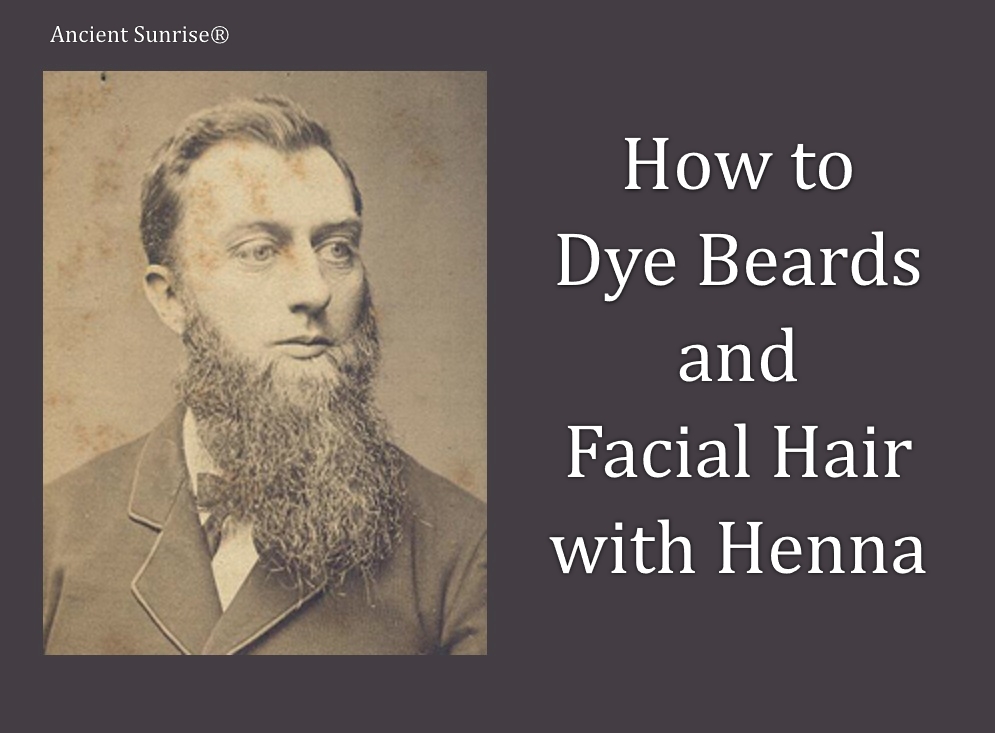
Henna has been used to dye and condition beards and facial hair for just as long as it has been used for hair on the head. Henna was used to dye hair in Persia as early as 1000 BCE. Persian men used henna alone or in combination with indigo to cover grays and to keep beards conditioned and healthy.
The use of henna for hair and beards was common throughout South Asia, the Arabian Peninsula, and the Middle East, and eventually spread to western regions, then throughout the world. At public baths, men relaxed and socialized while keeping up their washing and grooming habits, which included dyeing their beards. Henna made beards smoother, shinier, and stronger.

A man receives a Turkish massage at a public bath. Ottoman Empire, early 20th century.
In ancient times, Roman travelers noted that Persian men appeared to have woven gold wire through their beards. This was most likely a misinterpretation of their gray hairs which took on a copper shine after being hennaed. It was also common to dye the beard with indigo after it was hennaed, to achieve a jet black result. This is known as the two-step process.
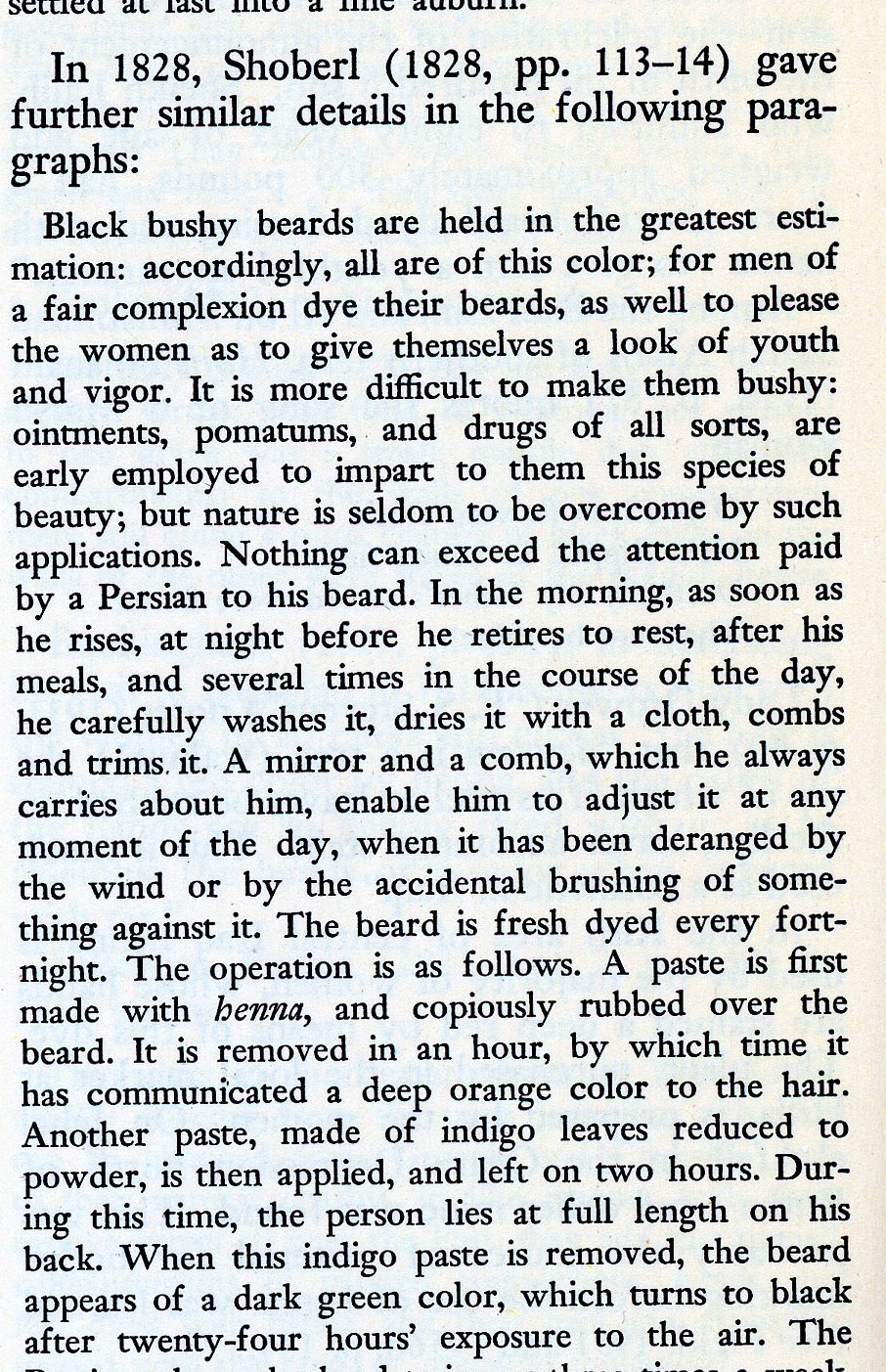
A section from “Body Marking in Southwestern Asia” by Henry Field. The observer describes the beard grooming rituals of Persian men.
In some cultures and regions, hennaed beards are seen as a sign of piety for Muslim men. Some interpretations of Islamic texts forbid men from dyeing their beards with anything but henna. Others see a hennaed beard as the mark of a hajji, or a person who has made the pilgrimage to Mecca. Photographer GBM Akash did a photo essay on the bright, hennaed beards of older Bangladeshi men, which you can see here.
Of course, the use of henna and other plant dyes is not exclusive to the Islamic faith. Henna is simply a product and technique which has been used in the contexts and regions where it naturally grows. As trade and travel grew, henna spread into western use.
Beards dyed with henna do not have to be bright orange. Just like it is used with the hair, combinations of henna and indigo (or henna, indigo, and cassia) can dye the beard to any natural color. A two-step process of dyeing the beard first with henna and then with indigo will result in jet black. Not only will using henna and other plant dye powders give you a more lustrous, thick, shiny beard; it has many benefits, including being safer for your health.
Switching from Commercial Dyes to Plant Dyes
Hair dyes marketed to men differ very little in their composition from hair dyes marketed to women. Most of them contain para-phenylenediamine. Contact dermatitis reactions to PPD will cause blistering, swelling, and difficulty breathing. When using such a product so close to the nose and mouth, these symptoms maybe particularly dangerous. Symptoms may worsen with each exposure, and can lead to hospitalization.
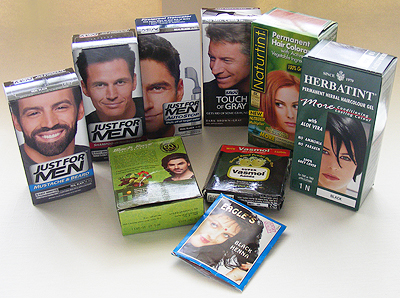
These products all contain para-phenylenediamine.
While it is true that fewer men than women use dyes, men are also less likely to discuss their hair dye use or to seek help when they experience adverse reactions. If men are unaware of the cause of their symptoms, they may continue to use products containing PPD and experience worsening reactions that may become life-threatening.
A series of class action suits is being pursued against Just For Men hair and beard dye for PPD-related injuries and the company’s potential failure to properly advise a skin patch test. One suit argues that the recommended patch test on the inner arm does not adequately predict and protect against reactions on the face, which can be more sensitive. Click here, here, and here for a few examples of current suits. If you have been affected by a PPD reaction from using a product by this company, consider searching for a class action suit in your area. A successful suit may contribute to better responsibility and regulation on the part of companies which manufacture and sell dyes containing PPD.
If you are interested in switching to Ancient Sunrise® products, our customer service team is more than happy to help you through the process. Ancient Sunrise® products can be used directly over previously processed hair without a waiting period, and will not react adversely to any products previously applied on the hair.
How to Dye Beards
The Mix
If you are familiar with how to mix henna, indigo, and cassia to achieve your desired color result, the mix for facial hair is exactly the same, but in smaller quantities. The average beard will probably need about 30-50 grams total of dry powder to create enough paste to cover. For a short, trim beard, you will need less. If you are Gandalf, you may need 100-200 grams or more. If you need help determining how much product to use, feel free to contact Customer Service.
You may want to keep the paste a little thicker to prevent dripping. This is especially recommended if you are dyeing a mustache, as it may be quite uncomfortable to have paste dripping onto the mouth. If you are new to using plant dye powders, be sure to check out Bare Essentials, Choosing Your Mix, and the Ancient Sunrise® free Henna for hair E-Book to get started.
Remember that you will be keeping the paste on your face for about three hours. If you are sensitive to the smell of henna, add a few pinches of ginger powder or cardamom powder to neutralize the smell. If you dislike the smell of indigo, add a few pinches of vanilla pudding powder.
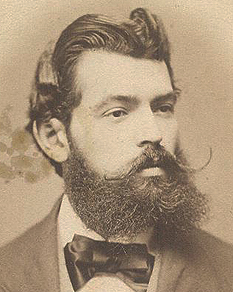
This dashing dude would need about 50-75 grams of powder to create enough paste for his beard and ‘stache.
Cleansing and Preparing
Facial hair can be dye-resistant, as it is thicker and grows quickly. Unlike hair on the head, it does not have the opportunity to be worn down by the elements (unless you have an impressively long beard). New hair is less porous than hair that has been subject to washing, brushing, and other forms of friction. Facial hair, like hair on the head, is kept moisturized and hydrophobic with a layer of sebum produced by the skin. It is important to make sure that your facial hair is extremely clean in order to achieve the best dye uptake.
It may be a good idea to exfoliate the skin with a good facial scrub or a stiff beard brush. The skin under facial hair can be dry and flaky. While henna does not stain skin on the face and head very well, scrubbing will further prevent staining, as henna binds to dry, thick skin. The last thing you’ll want is to have orange flaky bits hanging out in your luscious beard. A bonus to henna is that is has anti-fungal properties. If you experience dandruff around your facial hair, henna will take care of that. Scrubbing will also help lift the cuticles of the hair to better accept dye.
If you live in an area with hard water, clarifying with Ancient Sunrise® Rainwash Mineral Treatment is recommended. This will take care of any mineral buildup that can prevent adequate dye up-take, and ensure a better color result.
Wash your beard with a clarifying shampoo or a bit of dish detergent just prior to application. Once your face is scrubbed, clarified, and clean, you are ready to apply your paste.
Application
Make sure your paste has been prepared and dye-released at this point. If you wish, apply Vaseline or lip balm along the edges of your facial hair to prevent any staining that might occur. If you are applying to a mustache, you may want to put on lip balm as well. Be sure not to get any oil-based product on the hair itself. As mentioned previously, henna does not tend to leave a dark or lasting stain on the face, but it is always good to avoid looking like an oompa-loompa for a day.
Use gloved hands to apply the paste little by little, ensuring that the paste is worked down all the way to the skin, and the hair is thickly covered. Apply paste to the roots and pull it through to the ends. Press the hair down, or in the case of very long beards, twist it into rolls and press the rolls firmly into place.
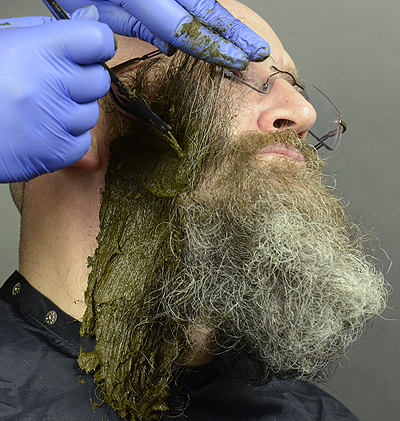
Thick, long beards will need to be hennaed in section to ensure even coverage.
Wrapping
Use a damp cotton swab to clean up the edges of your facial hair; your neck, lips, nostrils, ears, and so forth. Cover your facial hair with plastic wrap. One way to do this is to create a wide strip with holes on each end. Press the plastic along your chin and jaw, and loop the holes around your ears like a medical mask. For mustaches, cut a thinner piece and press it along your upper lip. Make sure you can breathe comfortably.
If desired seal the edges of the plastic with medical tape under the jaw to keep the plastic on place and prevent dripping. Finally, wrap the face with a scarf or bandanna, or put on a ski mask.
Processing
Just like on the head, henna mixes need about three hours or more to process for best results. Unfortunately, this means you’re stuck with paste on your face for a while. You can use heat to speed up the process. Men used to henna their beards as part of their regular bathing routine, and relax in the steamy public bath or sauna. Hang out in a steamy bathroom or steam your face for a few minutes at a time. You could also apply a heating pad to your face periodically. Be sure to avoid long exposure to high heat, as this can be damaging to the delicate skin on the face.
Rinsing
Wash out the paste with warm water. You can do this over the sink, or submerge your face in a warm bath and swish it around. Apply conditioner and pull it through to help any residual paste rinse away. Finally, finish with shampoo or face cleanser. Remember to moisturize your beard and face after all that it’s been through.
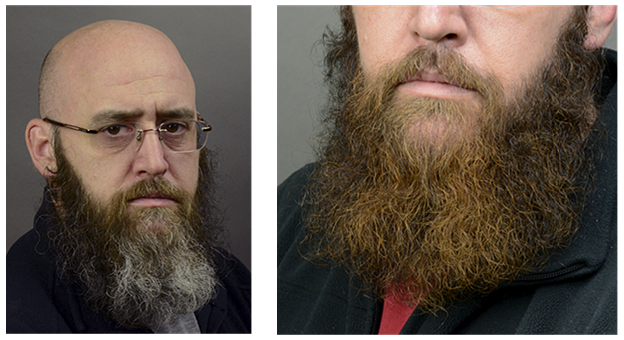
Here is Mark’s beard before and after an application of henna and indigo.
Touch-ups
Facial hair grows quickly. How frequently you re-apply your henna mix will be dependent on your facial hair style and personal preference. If you keep your beard clipped short, you may need to touch it up more frequently, as you shave away the areas that are dyed.
It will be helpful to have henna on hand that is pre-mixed, separated into portions, and frozen. If you are using only henna and/or cassia, simply thaw a portion and apply. If you are using a mix containing indigo, thaw your henna paste, mix fresh indigo, and stir them together.
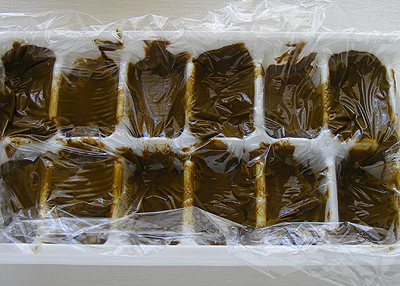
Freeze henna paste into cubes for easy storage and future use.
Once you have dyed all of your facial hair once, it is not necessary to do all of it again. You can use a tool such as a small tinting brush or an old toothbrush to help you apply paste just at the roots. This will keep reapplications clean, easy, and affordable.
Reapplications will require the same preparation and processing methods as your first dye. Remember to thoroughly clean the facial hair and face beforehand, and leave the paste in for three hours, or less if applying gentle heat.
If you are using a henna/indigo mix to dye graying hair to a brunette shade, and notice your facial hair becoming lighter or redder over time, you can easily darken it up again with a quick application of indigo paste. Simply mix about a tablespoon of indigo with distilled water, apply through your facial hair, and rinse after 10-15 minutes. This technique can be repeated until you achieve your desired results, and used as often as necessary. Note: Unless you would like to have a blue beard, do not apply indigo alone to gray hair.
For more information, read http://www.hennaforhair.com/beards. To speak to a customer service representative and/or to place an order, visit www.mehandi.com.
